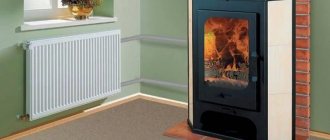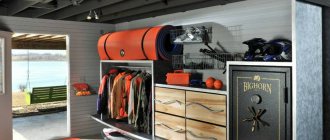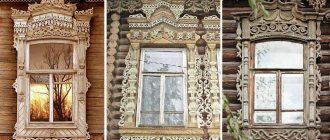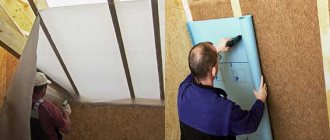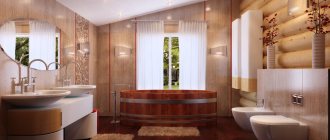The desire of residents of large cities to escape the pollution of megacities and live quietly in their cottages in nature is causing rapid construction of private houses. People most often choose environmentally friendly designs from:
- plain or rounded logs;
- glued or regular timber;
- frame blocks.
The construction of such buildings requires taking into account the performance properties of wood and products made from it.
Design features of wooden houses that influence the choice of heating systems
When choosing a heating scheme for a wooden house, you should consider:
- number of storeys;
- volume of premises;
- shrinkage ability of the building;
- floor construction made of boards on joists.
The number of floors and the capacity of the heated space influence the choice of heating system based on performance, which should create comfortable living conditions even in cold weather.
The fibrous structure of wood contains air, which prevents heat transfer and serves as a good natural heat insulator. However, over time, the relative humidity of even prepared dried wood decreases. The drying process is especially noticeable after the first year of operation of the building, in which the proportions are slightly reduced, and cracks form at the tightly fitted joints of the boards.
Changing the geometry of the walls can not only deform vertical pipelines, but also break their tightness.
In order to prevent such breakdowns, heating is installed a year after the wooden frame is assembled or expansion loops and other devices are used at pipe joints.
When designing electric heating in a wooden house, one should take into account the shrinkage, shrinkage and fire hazard of wood, not forgetting the general thermal insulation.
In this case you can use:
- water/liquid electric boiler, powered by electricity and controlled by an automation system;
- warm floor;
- direct electric heating: radiators and convectors;
- infrared radiation;
- baseboard heating;
- scheme of forced or natural circulation of warm air.
Electric boiler
The most effective industrial designs and home-made devices made by folk craftsmen allow you to choose a liquid heating scheme for a wooden house, taking into account climatic and financial capabilities.
When using a system for transferring heat to rooms using radiators, you should consider the piping layout. It can be two-pipe or single-pipe. Each of them has its own advantages. They should be carefully analyzed at the design stage.
Industrial designs of electric boilers use a built-in automation circuit set up in the factory. If you manufacture an electric boiler yourself, you will have to manually regulate its operation or install an additional control and temperature monitoring system.
The automation algorithm will need to take into account the operation of the temperature controller, the safety unit - a safety valve with a pressure gauge, a minimum temperature sensor, a check valve, pressure and anti-condensation pumps, and a water replenishment circuit in the system.
Electricity from alternative sources can be used to heat water from heating elements. A simple homemade wind generator connected without a controller directly to thermal electric heating elements can effectively heat water.
The only condition is that you will have to provide a circuit for putting it into operation: in a cold state, the nichrome wire of the heater has a low ohmic resistance, which will bypass the output circuits of the wind generator. Before connecting it, you will need to heat the nichrome with currents from a stationary network. The resistance of the heating elements will increase and allow the generator to operate.
The energy of a solar battery can be used in the same way, although the integrated inclusion of a wind generator in an electric home solar station is considered the most promising option.
About the coolant used
Electrode boilers do not require a specially prepared coolant; ordinary water can be used for this (provided that its resistivity does not exceed 1.3 kOhm/cm). In this regard, the water still needs some preparation. So, if you simply fill it with distilled water, it will not bring any success, because it does not conduct electricity.
The preparation process consists of conducting experiments, as a result of which the resistance increases (baking soda is used for this, for aluminum appliances - ASO-1) or decreases (melt or rainwater is added).
Prices for the range of electric boilers
Electric boiler
Warm floor
The underfloor heating system is based on the use of thermal energy obtained from:
- coolant fluids circulating along lines located under the surface of the floor covering;
- heated electrical cable embedded in the floor.
Electric heated floor.
When using electric heating in a wooden house for such a system, you will have to take care of creating a solid, strong and durable foundation for it. Floor boards can rot over time even after impregnation with special antiseptics. Therefore, it is better to install heating elements on concrete bases using foil heat-insulating coatings, which allow you to return up to 30% of the heat directed down the floor.
The water system requires complex installation by trained specialists and the constant use of only high quality water. Scale and salt deposits inside pipes are unacceptable: the resulting blockages will require expensive repairs, comparable in cost to installing new equipment.
Installation work on an electric heating cable also requires strict implementation of technology and the use of precise measurements, but they are not so complicated and can be performed by a home craftsman.
A warm electric floor can:
- serve as the main heating system of a wooden house;
- complement the existing one to ensure comfort.
In the first case, for each room it will be necessary to use ≥70% of the total area to place heating elements with a consumption capacity of 0.13÷0.17 kW/m2.
Reducing the power to 0.11÷0.13 kW/m2 provides coziness and convenience, but does not completely solve the problem of heating in cold weather.
Both schemes allow:
- adjust the temperature in the room manually or automatically;
- reduce the cost of using electricity using automation;
- operate the system for more than 50 years without repairs.
Conclusion
An electrode boiler is a good solution for dachas and country houses. Its installation does not require permits or a separate room, and its operation does not require increased safety requirements. You can make such a device yourself, but how practical it is is up to you to decide. Although the water heater has a very high efficiency, its use is still much more expensive than the operation of its gas counterpart . It is also worth noting that the ion boiler is demanding on the coolant and heating system. If you do not comply with the mandatory requirements, the device will work ineffectively and will last much less than the stated period.
Direct electric heating
Oil radiators
The housings of these devices consist of several sections with mineral oil as a coolant, which is heated by powerful heating elements up to 200 degrees, maintaining the radiator temperature no higher than 100 degrees.
Oil radiators are capable of heating any living space; they do not “burn” oxygen during operation, but they are used only in extreme cases due to the high consumption of electrical power.
Convectors
In these devices, a heating element heated by electric current directly heats the air without an intermediate coolant. Therefore, they have higher heat transfer and efficiency, but at the same time some of the oxygen is burned out of the air in contact with the hot metal of the heater.
With the radiator and convector method, cold air from below the room, after heating, rushes upward and collects near the ceiling, and from there it is distributed throughout the entire volume of the room.
Therefore, when the temperature at the top of the room reaches +22°C, the air near the floor will warm up to +17°C, which is quite acceptable, but not entirely comfortable.
Convectors use temperature sensors with automatic temperature control systems, which can significantly save energy costs.
Attention! The convector located below the window protects the room from the penetration of cold air through cracks from the street, preventing drafts.
Principle of operation
Many people are familiar with the simplest boiler circuit - two safety razor blades connected to wires. Such a “heater”, constructed from scrap materials, is dangerous, but is still capable of quickly boiling, for example, a mug of water. It uses the phenomenon of electrolysis: water contains various substances and metal salts, and if current is applied to contacts immersed in water, charged particles will begin to move from one contact to another. In household electrical networks in the Russian Federation, the current frequency is 50 Hertz, therefore, the ions will change direction 50 times per second. This causes heating. The same principle is used by an electrode heating boiler.
The speed at which the operating temperature is reached is affected by the composition of the water: the more salts it contains, the lower the resistance and the faster the movement of charged particles. And Ohm's law states that at a constant voltage, a decrease in resistance causes an increase in current. The conductive properties of water are worse than those of metals used in electrical engineering (aluminum, copper), therefore, as the current increases, it actively heats up. Due to this, the efficiency of electrode boilers is very high: they convert a significant part of the energy supplied to them into heat.
The boiler power is calculated by the formula P=UI, where P is the power in watts, U is the mains voltage (220 V in single-phase networks and 380 in three-phase networks), I is the current in amperes.
Infrared heating system
This circuit uses an electric heater to generate infrared radiation that is directed in all directions, usually from top to bottom. Heat waves affect not so much the air in the room, but rather the solid objects in the room: the floor, furniture, fabrics...
Such electric heating of a wooden house is considered beneficial for the human body. Infrared rays are directed at objects and the human body, heating them first.
The efficiency of existing IR system heaters reaches ≈90%, which indicates their high efficiency. However, you need to carefully analyze the financial costs: the price of infrared equipment is quite high.
For comparison with convector heating: the thermal radiation method allows you to create a temperature of +22°C near the floor, while near the ceiling it will only reach +17°C.
Design features
From a structural point of view, such a boiler is a small all-metal pipe coated with polyamide (it acts as an insulator). The coolant input and output, as well as power terminals, are connected to the housing. A set of insulated electrodes is inserted into the pipe on one side, while the other is hermetically sealed.
Electrode boiler
Let's consider the technical parameters of factory models.
- Length – up to 60 cm, diameter – no more than 32 cm.
- The power can vary between 2 and 50 kW, in other words, the boilers are capable of heating a room of up to 1500 m².
- They can also be single- and three-phase. In the first case, we mean low-power appliances used in private homes, in the second - high-performance boilers intended for industrial facilities.
- The optimal value of energy consumption is achieved at a working fluid temperature of 75ᵒC. If the indicator is higher, then energy consumption increases, and if it is lower, then it, accordingly, decreases (at sub-zero temperatures, the thermal conductivity of the liquid worsens).
The operating principle of an electrode boiler. Comparison of electrode and heat boilers
Based on the method of coolant supply, ion devices can be of two types:
- open systems are characterized by the fact that the heated liquid moves naturally, transfers heat and is sent back to the heat generator;
- closed ones have a special pump and expansion tank - they are necessary for the initial stage of warming up the working fluid.
Boiler piping
Video - How the boiler works
Baseboard heating
This method fits well into any original design and architectural solutions. It is simply mounted on any type of surfaces and finishing materials (brick, concrete, tiles, drywall, wood).
To heat the room, heat transfer sources are built into a special baseboard, reminiscent in appearance of ordinary models, but of increased size.
Heat can be transferred:
- water circulating through pipelines;
- electric heating elements connected by cable.
The operating principle of a baseboard heating circuit.
The system’s radiators are mounted along the bottom of the wall along the entire perimeter of the room or in certain areas of it. There are holes at the bottom and top of the plinth housings for free access of air, which comes from the floor level and is directed upward when heated.
The heat of the heating elements “sticks” to the plane of the wall, being transferred to its surface and to the surrounding air, which is evenly mixed in the volume of the room.
Advantages of the scheme
For baseboard heating:
- the processes of condensation appearing on the wall are eliminated;
- energy savings by 20÷40%;
- air and temperature inside the room are evenly distributed.
Temperature distribution and air flow in a room with baseboard heating.
Features of installation and operation
Water supply pipelines for liquid heating and power cables of heating elements are hidden in the floor or walls and filled with cement mortars. Therefore, their placement should be taken into account in the building design. Reworking or correcting mistakes is difficult.
The plinth is made of copper or aluminum - metals with high thermal conductivity coefficients. For effective operation, it is enough to heat them to +40°C, not higher.
The system allows you to use a thermostat in each room to automatically maintain a certain temperature. For example, in the children's room you can slightly increase the heating, and in the bedroom - reduce it.
Placing the baseboard under the window protects against drafts.
For complete heat exchange, the baseboard bodies should not be covered with fabrics, decorative grilles, or furniture.
Building air heating system
Such schemes were used back in the 18th century in multi-story castles. They are created during the construction of a house and operate from an electric air heater located on the ground floor. The heat from it is distributed through rectangular, oval or round air ducts to all rooms. Blower fans are used to circulate air. Thanks to the convenience of controlling the temperature of one heater, such a system is economical.
Its disadvantages:
- the need for supervision by specialists;
- difficulty regulating temperatures inside different rooms;
- complexity of installation.
The air heating system is used more often in industrial buildings with heat sources created by production processes. It is rarely installed in residential buildings.
In order to effectively use electric heating in a wooden house, it is necessary to select the most suitable scheme at the design stage, and during installation and operation strictly follow the technology and manufacturer’s recommendations.
